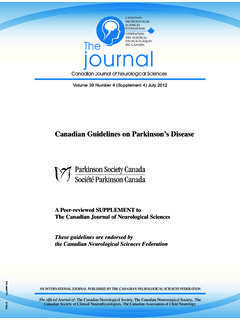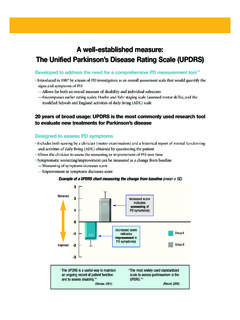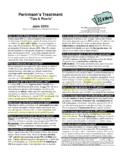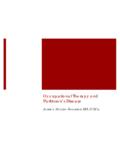Transcription of Bladder Dysfunction in Parkinson’s Disease
1 Bladder Dysfunction in parkinson 's Disease Randolph Stephenson, MD. Neurology Center of Fairfax Outline Incontinence in the general population Prevalence Types of incontinence Causes Evaluation treatment Bladder symptoms in parkinson 's Disease Causes Assessment treatment Age of women ages 20 to 29; 33% of women ages 54 79; 38% of women over 80 (Wu et al., 2014). of men ages 19 to 44; of men ages 45 64; of men over the age of 65. Incontinence and Quality of Life Associated with lower quality of life Negative impact on caregivers (Gotoh et al. 2009). Tendency to alter daily routine: work less hours during the day. Avoid going far from home. Greater affect on emotional and social wellbeing on men than in women (Tennstedt et al. 2010). Men are half as likely as women to get help. Risk Factors Multiple pregnancies and births Prostate Disease Obesity strongest risk factor in women Diabetes History of frequent urinary tract infections Age Depression Constipation Neurological Disease Screening questions Do you leak urine unintentionally?
2 Do you leak urine on the way to the bathroom? Do you leak urine with laughing or sneezing or coughing or exertion? Types of Incontinence Stress incontinence leakage caused by activity, sneezing or coughing. Urge incontinence leakage following sudden urge to urinate without being able to control that urge. Overflow incontinence leakage caused by overflow' of urine from an overly full Bladder because of not completely emptying the Bladder . Mixed incontinence typically a combination of both urge and stress incontinence. Most common type in women. Types of Incontinence Mechanism Stress incontinence causes Prostate surgery can damage the urethral sphincter. In women this often happens as a result of childbirth which causes loss of pelvic floor support. It can also be related to obesity, chronic cough or chronic high impact activity. Mechanisms ctd Mechanism ctd Urge incontinence or overactive Bladder is difficult to sort out.
3 Most common type in men. Most common type in parkinson 's Disease . Faulty signals from the Bladder to the brain as is seen in nerve problems. This is common in diabetes. Inability of the brain or spinal cord to control Bladder common in various neurological conditions such as spinal cord injury, multiple sclerosis, parkinson 's Disease . Can come from the Bladder muscle itself being overactive which happens with aging. Mechanism ctd Overflow incontinence is leakage or dribbling when the Bladder has not completely emptied. Bladder is Underactive as opposed to urge incontinence which happens with Bladder Overactivity. Age related. Nerve problems (neuropathy) such as with diabetes, vitamin b12 deficiency, alcoholism or with damage to the spinal nerve roots as is commonly seen with lower back spinal stenosis. Also can come from things that compress the urethra such as tumors, fibroids, vaginal prolapse, prostate enlargement.
4 Mechanisms ctd Smoking Alcohol and caffeine intake Severe constipation and stool impaction Urinary tract infection Cognitive impairment Normal Pressure Hydrocephalus Cancer ( Bladder cancer). Evaluation Take a good history Classify the type of incontinence (urge vs. overflow vs. stress). Are there other symptoms such as pain, fever, bleeding, sudden onset? Medications diuretics, memory medications, caffeine, nicotine. Diary timing of the incontinence, does it occur with heavy fluid intake, what is the maximum time in between voiding. Most places use a 3 day diary but a 24 hour diary is more easy for compliance purposes. Bowel function Sexual function History of prostate problems Impact on quality of life this can guide treatment as it can target the most disruptive symptoms. Evaluation ctd. Physical exam all women with incontinence should receive a pelvic exam and all men should receive a prostate exam.
5 Everyone with incontinence should receive a urine analysis. Kidney function should be checked in anyone with overflow incontinence as urine can back up into the kidneys and cause kidney swelling. Evaluaton ctd. Bladder stress test can be used to assess whether stress incontinence is present. Patient is examined with a full Bladder and asked to cough or bear down. Post void residual the patient either is catheterized after voiding or receives an ultrasound to determine how much urine is left in the Bladder . This is done mainly with overflow incontinence or when urinary retention is suspected. Anything over about a cup (or 200 ml) is abnormal. Urodynamic testing not routinely used as it is invasive and expensive and rarely dictates treatment . treatment Stepwise approach! Start from the least invasive treatments and progress to the more invasive treatments as necessary. What causes can be changed?
6 Offending medications? Urinary tract infection? Is there functional problem where the patient can't get to the bathroom on time? What are the most bothersome symptoms? It is crucial to discuss the Goals of treatment and manage expectations! treatment ctd Least invasive Lifestyle modifications Weight loss Dietary changes cut back on alcohol, caffeine and carbonated beverages. Cut back on excessive fluid intake but avoid dehydration! Cut back on night time fluid intake if nocturia. Smoking cessation treatment ctd Behavioral treatment Pelvic floor (Kegel) exercises more effective in women. Used in stress and urge incontinence mainly. Strengthening of pelvic floor muscles provides support around the urethra which can block Bladder contractions. Biofeedback can be helpful if patients have trouble isolating these muscles. Bladder training used mainly with urge incontinence. Use of a voiding diary is required.
7 Patients then void at regular timed intervals using the shortest times demonstrated in the diaries that patients can go without voiding. Urgency episodes are dealt with by distraction and Kegel movements. Voiding intervals are gradually increased over the course of several weeks. Other non-medication treatments Pessaries Weighted vaginal cones Surgery mainly for stress incontinence Pads treatment of secondary causes of incontinence ( , spinal cord compression, UTI, pelvic floor tumors). Drugs Alpha blockers Tamsulosin (Flomax), doxazosin (Cardura), terazosin (Hytrin), alfuzosin (Uroxatral). Used to treat urge and overflow incontinence in men with enlarged prostates. Side effects include orthostatic hypotension and dizziness. Anticholinergic drugs Oxybutynin (Ditropan), tolterodine (Detrol), darifenacin (Enablex), solifenacin (Vesicare), fesoterodine (Toviaz), and trospium (Sanctura).
8 Most common medications used to treat urge incontinence and overactive Bladder in both men and women. Side effects include blurred vision, dry mouth, constipation, fast heart rate and confusion/hallucinations. Shouldn't take if have narrow angle glaucoma, severe constipation or if on memory drugs such as Aricept. Drugs ctd. Mirabegron (Myrbtetriq) is now being used in patients with urge incontinence who can't tolerate anticholinergic medicine. Associated with less dry mouth and constipation. Can cause high blood pressure. Botox injections weaken the Bladder muscle. Helpful for urgency/urge incontinence which could be helpful in parkinson 's. Caution against patients with atypical Parkinsonism such as MSA. because the problem there is often Bladder Underactivity and could result in not being able to empty the Bladder . Urinary symptoms and parkinson 's Disease Studies have shown prevalences ranging from 27% to 85% for urinary symptoms in Parkinsons patients.
9 (McDonald et al. 2016). Large discrepancy in prevalences is a reflection of the diversity of different parkinson 's populations. Some studies also probably accidentally include atypical parkinsonian patients where urinary symptoms are more common such as with MSA. The Priamo study (Barone et al., 2009) was quite thorough and probably has the most accurate estimate. Urinary symptom prevalence was around 57 %. Urinary symptoms in PD ctd In decreasing order of symptom prevalence (Fahn, Jancovic, 2007): Nocturia Frequency Urgency Urge incontinence Hesitancy and Bladder retention Urinary symptoms in PD ctd Urinary incontinence within one year of diagnosis suggests atypical parkinsonism or another cause unrelated to parkinson 's Disease (Fahn &. Jancovic, 2007). Again, MSA is often associated with not being able to empty the Bladder and overflow incontinence whereas patients with PD have urgency related problems or just can't get to the bathroomon time.
10 Also, urinary incontinence in PD Usually starts years after diagnosis. Urinary symptoms and PD ctd. It is unclear if the degree of urinary symptoms is associated with Disease severity (McDonald et al, 2016). Some studies have shown that urinary symptoms (other than incontinence) in general don't occur until years after the diagnosis while other studies show patients have symptoms at the time of diagnosis and before. In my experience many patients can present with nocturia at the time of diagnosis unrelated to any other obvious cause. I also have patients who have urinary symptoms at the time of diagnosis related to other medical problems such as prostate issues and multiple births in my female patients. Urinary symptoms and PD ctd It is also variable as to what extent urinary symptoms affect quality of life. In general, urinary incontinence is the most bothersome symptom (McDonald et al.)




